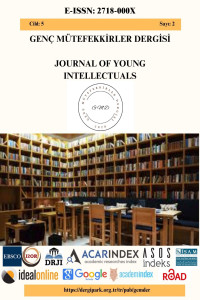Can the Sign be Thought of as a Space? An Analysis of the Sign in the Context of Plato's Concept of Chōra
Abstract
Plato uses the concept of chōra, which he first introduced in Timaeus, one of his late dialogues, to solve one of the most important problems of Ancient Greek thought, namely the explanation of the sensible world by the intelligible world. Chōra is positioned as a third genus (genos) alongside the intelligible eidos and their sensible copies, and by establishing the relation of the former to the latter, it makes it possible to explain the sensible in terms of the intelligible. The chōra, also referred to by Plato as the container of becoming, is a space that provides a “place” for everything in it. In this article, based on Plato’s chōra as the space in which becoming takes place, we argue that signs can be interpreted as a chōra in the sense that they “become transparent” and show something other than themselves and in this sense become the space of something else. In this sense, we argue that signs are an “interface” and “space” that the human psyche uses to present meanings to itself. Thus, the article attempts to show that there is a fundamental act of spatialization, both in the case of the space of physical objects and in the presentation of meanings to ourselves through signs.
References
- Aristotle, Physics, not. William David Ross, Oxford: Clarendon Press, 1936.
- Çitil, A. A., “Saf Görü, Biçimsel Dizge, Turing Makinesi ve Frege’nin Kavramyazısı”, Felsefi Düşün, Sayı 7, s. 45- 69, İstanbul, Ekim, 2016.
- Haşlakoğlu, O., Platon Düşüncesinde Tekhnê: Sanat ve Felsefenin Ortak Kökeni Üzerine Bir İnceleme, Sentez Yayınları, 2016.
- Hoenig, C., “Calcidius”, Brill’s Companion to the Reception of Plato in Antiquity, Brill Academic Pub., 2017.
- Johansen, T. K., Plato’s Natural Philosophy: A Study of the Timaeus-Critias, Cambridge, New York: Cambridge University Press, 2008.
- Kahn, C. H. Plato and the Post-Socratic Dialogue: The Return to the Philosophy of Nature, Cambridge University Press, 2014.
- MacDonald C., Francis, Plato’s Cosmology: The Timaeus of Plato, Indianapolis/Cambridge, Hackett Publishing Company, 1997.
- Miller, Dana R., The Third Kind in Plato’s Timaeus, Vandenhoeck & Ruprecht, 2003.
- Peters, Francis E., Antik Yunan Felsefe Terimleri Sözlüğü, çev. ve haz. Hakkı Hünler, İstanbul: Paradigma Yayınları, 2004.
- Platon, Kratylos, çev. Erman Gören, İstanbul: Dergâh Yayınları, 2016. Platon, Sofist, çev. ve not. Ömer Naci Soykan, İstanbul: Pinhan Yayınları, 2015. Platon, Timaios, çev. Özgüç Orhan, İstanbul: Fol Yayınları, 2022.
İşaret Bir Mekân Olarak Düşünülebilir mi? Platon'un Khôra Kavramı Bağlamında İşarete İlişkin Bir İnceleme
Abstract
Platon ilk kez geç dönem diyaloglarından olan Timaios’ta ortaya koyduğu khôra kavramını, Antik Yunan düşüncesinin en önemli problemlerinden birisi olan metheksis meselesini, yani duyulur dünyanın akledilir dünya tarafından açıklanmasını çözmek üzere kullanır. Khôra, akledilir olan eidoslar ile onların duyulur kopyalarının yanında üçüncü bir cins (genos) olarak konumlanır ve ilkinin, ikincisi ile ilişkisini kurarak duyulur olanın akledilir olan bakımından açıklanabilmesini mümkün kılar. Platon tarafından oluşun kabı olarak da ifade edilen khôra, kendisinde bulunan her şeye bir “yer” sağlayan bir mekândır. Bu makalede ise Platon’un oluşun kendisinde gerçekleştiği mekân olarak khôradan yola çıkarak işaretlerin, “şeffaflaşarak” kendilerinden başka bir şeyi göstermeleri ve bu anlamda bir başka şeyin mekânı hâline gelmeleri bakımından bir khôra olarak yorumlanabileceğini ileri sürüyoruz. Bu anlamda işaretlerin, insan ruhunun kendine anlamları sunarken kullandığı bir “ara yüz” ve “mekân” olduğunu ifade ediyoruz. Böylece makale, hem fiziksel nesnelerin mekânı söz konusu olduğunda hem de anlamların işaretler aracılığıyla kendimize sunulmasında olduğu gibi temelde bir mekânlaştırma fiilinin bulunduğunu göstermeye çalışmaktadır.
Keywords
References
- Aristotle, Physics, not. William David Ross, Oxford: Clarendon Press, 1936.
- Çitil, A. A., “Saf Görü, Biçimsel Dizge, Turing Makinesi ve Frege’nin Kavramyazısı”, Felsefi Düşün, Sayı 7, s. 45- 69, İstanbul, Ekim, 2016.
- Haşlakoğlu, O., Platon Düşüncesinde Tekhnê: Sanat ve Felsefenin Ortak Kökeni Üzerine Bir İnceleme, Sentez Yayınları, 2016.
- Hoenig, C., “Calcidius”, Brill’s Companion to the Reception of Plato in Antiquity, Brill Academic Pub., 2017.
- Johansen, T. K., Plato’s Natural Philosophy: A Study of the Timaeus-Critias, Cambridge, New York: Cambridge University Press, 2008.
- Kahn, C. H. Plato and the Post-Socratic Dialogue: The Return to the Philosophy of Nature, Cambridge University Press, 2014.
- MacDonald C., Francis, Plato’s Cosmology: The Timaeus of Plato, Indianapolis/Cambridge, Hackett Publishing Company, 1997.
- Miller, Dana R., The Third Kind in Plato’s Timaeus, Vandenhoeck & Ruprecht, 2003.
- Peters, Francis E., Antik Yunan Felsefe Terimleri Sözlüğü, çev. ve haz. Hakkı Hünler, İstanbul: Paradigma Yayınları, 2004.
- Platon, Kratylos, çev. Erman Gören, İstanbul: Dergâh Yayınları, 2016. Platon, Sofist, çev. ve not. Ömer Naci Soykan, İstanbul: Pinhan Yayınları, 2015. Platon, Timaios, çev. Özgüç Orhan, İstanbul: Fol Yayınları, 2022.
Details
| Primary Language | Turkish |
|---|---|
| Subjects | Systematic Philosophy (Other) |
| Journal Section | Research Articles |
| Authors | |
| Early Pub Date | June 10, 2024 |
| Publication Date | June 14, 2024 |
| Submission Date | May 13, 2024 |
| Acceptance Date | June 2, 2024 |
| Published in Issue | Year 2024 Volume: 5 Issue: 2 |


